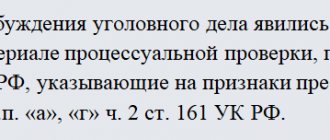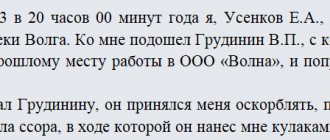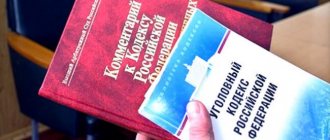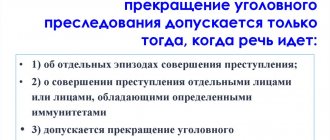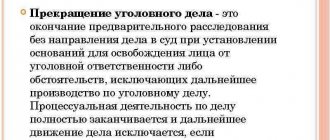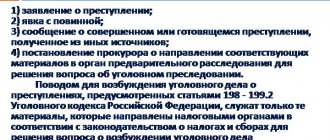Art. 140 of the Code of Criminal Procedure of the Russian Federation regulates the reasons for initiating a criminal case and calls the only basis the presence of sufficient data indicating signs of a crime. The decision is made in the presence of any reason and grounds provided for in Art. 140 of the Code of Criminal Procedure of the Russian Federation, according to Part 1 of Art. 146 Code of Criminal Procedure of the Russian Federation. It states:
- place, time, date of issue;
- the position of the person who made the decision;
- the reason and basis for initiating a criminal case;
- an indication of the paragraphs, parts, articles of the Criminal Code of the Russian Federation that are the basis for starting an investigation.
Regarding the application of the provisions of paragraph 3 and paragraph 4 of Part 2 of Art. 146 of the Code of Criminal Procedure of the Russian Federation there are many discussions in practice. Lawyer B. filed a complaint with the court under Art. 125 of the Code of Criminal Procedure of the Russian Federation in the interests of suspect S. to the resolution of the investigator of the Investigation Department of the Moscow Department of the Ministry of Internal Affairs of the Russian Federation F. to initiate a criminal case against S. on the grounds of a crime under Part 3 of Art. 159 of the Criminal Code of the Russian Federation. He stated that in violation of the requirements of paragraph 3 of Part 2 of Art. 146 of the Code of Criminal Procedure of the Russian Federation, the resolution does not indicate the reason and basis for initiating a criminal case.
The appellate instance, on the contrary, indicated that the investigator had reason and grounds, since this decision was made based on the results of consideration of the audit material on the report of the crime registered in the accounting book. The inspection was carried out by the body of inquiry in accordance with Art. 144-145 Code of Criminal Procedure of the Russian Federation. But the court gave a reason for initiating a case without specifying the reasons. This is the appeal ruling of the Moscow Regional Court dated June 24, 2014 in case No. 22k-3647/2014.
A similar situation arose in another case, in which the Appeal Resolution of the Moscow Regional Court dated January 20, 2015 No. 22K-8158/2014, 22-282/2015 was adopted. The lawyer appealed to the court of one of the constituent entities of the Russian Federation with a complaint under Art. 125 of the Code of Criminal Procedure of the Russian Federation on recognizing as illegal the decision of the investigator of the Investigative Directorate of the MU of the Ministry of Internal Affairs of Russia to initiate a criminal case against R. on the grounds of a crime under paragraph 6 of Part 2 of Art. 171 of the Criminal Code of the Russian Federation. By decision of the city court, the lawyer's complaint was left unsatisfied. The defense lawyer noted that the court of first instance indicated that there were grounds and reasons for initiating a criminal case, since the case materials contained reports from detectives about the discovery of signs of a crime. However, according to Part 1 of Art. 140, art. 143 of the Code of Criminal Procedure of the Russian Federation, the detective’s report is only a reason to initiate a criminal case, and the resolution, in accordance with Part 1 of Art. 146 of the Code of Criminal Procedure of the Russian Federation, can be issued only if there is a reason and grounds.
According to Part 2 of Art. 140 of the Code of Criminal Procedure of the Russian Federation, the basis for initiating a case is the presence of sufficient information indicating signs of a crime. But they were absent. The appellate instance decided that the circumstances contained in the complaint are related to the assessment of evidence and qualification issues, and therefore cannot be the subject of assessment when considering this complaint in accordance with Art. 125 Code of Criminal Procedure of the Russian Federation.
The above examples raise the question: how can one appeal the legality of a decision without challenging the very classification of the crime?
Note!
The reason for initiating a criminal case, according to Art. 140 of the Code of Criminal Procedure of the Russian Federation is a statement of a crime or a report of it, and the basis is the presence of sufficient data indicating signs of a violation of the law. It follows that the establishment of this information presupposes its qualification.
The analyzed position is also directly enshrined in paragraph 16 of the Resolution of the Plenum of the Supreme Court of the Russian Federation dated February 10, 2009 No. 1.
The procedure for deciding to initiate a criminal case on the fact of theft
To initiate a criminal case, the following reasons are required:
- citizens' statements;
- messages from the administration of government agencies and public organizations, private companies, enterprises;
- statements of witnesses about facts that contain signs of a crime;
- detection of violations by the investigator or body of inquiry.
Note!
After receiving the application, a brief survey of the applicant is conducted. If the information contained in the appeal is contradictory or for other reasons raises doubts about its reliability, an inspection of the scene of the incident is carried out to decide whether to initiate a criminal case.
At the stage of theft investigation, three typical investigative situations arise:
- the suspect is detained.
In this case, it is necessary to collect evidence of the person’s involvement in the crime committed, to establish the specific circumstances of the event, and to locate the stolen property. It is more expedient for the investigator to carry out a number of activities: detention, personal search, examination of the suspect, inspection of the scene of the incident, interrogation of victims or financially responsible persons, witnesses, the suspect himself, search of the place of residence of the alleged attacker;
- the suspect has not been detained, but there is some information about his identity.
The main focus of the investigation is aimed at studying the situation in which a criminal offense was committed, collecting and securing evidence about the perpetrators, stolen valuables, and the circumstances of the crime. It is necessary to conduct an interrogation of victims or financially responsible persons, an inspection of the scene of the incident, interrogation of witnesses, forensic examinations, operational search activities;
- Law enforcement agencies do not have information about the person who committed the crime.
In this case, the investigator will work in a research and search direction. The main task: to obtain information about the crime committed through non-procedural means. In addition to investigative actions, operational search activities are carried out to identify the criminals, search for stolen goods, check the method of the illegal act, study traces, collect a description of signs of stolen things using forensic records and other measures.
Forensic characteristics of thefts. Circumstances to be established
Theft, i.e. secret theft of other people's property is among the most common crimes against property (Article 158 of the Criminal Code of the Russian Federation).
The most common thefts are from apartments, dachas, garages and other premises belonging to individual citizens, theft of personal belongings at stations and on trains, pickpocketing in markets, shops, public transport, and also on the streets. The direct objects of criminal attacks are money (including foreign currency), audio and video equipment, jewelry, clothing, cars, motorcycles, bicycles, and less often (in case of thefts from dachas) - household utensils and food. In recent years, theft of crops from fields and gardens has become widespread.
Thefts from shops, warehouses and other places where material assets are stored or sold are also often committed.
The methods of committing thefts are very diverse. They can be classified as follows:
- theft of state or public or personal property of citizens from premises; they can be committed both by breaking (criminals pick locks, press or knock down doors, expose windows) and without breaking (for example, by picking a key);
- theft of personal property of citizens not related to entry into premises (pickpocketing, theft from bags, including by cutting bags and pockets; fleecing drunks; theft of suitcases, bags and other things);
- thefts committed by breach of trust; Among them, a distinction is made between thefts with penetration into the premises, when the victim allows the thief into his apartment, and without penetration into the premises (a typical example is the so-called “assisted thefts” at train stations, when a passenger entrusts his property to an unfamiliar person and leaves for a short time);
- theft from automatic lockers;
- vehicle theft;
- theft from cars, etc.
Apartment burglaries most often occur during the day, when apartment owners are not at home; thefts not related to entry into premises - both in the morning and evening, and during the daytime. Pickpockets operate in crowded places (city transport, shops).
The traces left by criminals when committing thefts are very diverse and largely depend on the types of thefts and the methods of their commission. Thus, during thefts from premises and from cars, mainly material traces of the crime remain (burglary tools, hands, shoes, etc.). In the case of thefts committed by abuse of trust, on the contrary, intellectual traces predominate (victims, and sometimes witnesses, give a fairly complete description of the criminal’s appearance and usually confidently identify him). There are almost no traces left when committing thefts of personal property that are not associated with penetration into the premises (pickpocketing, thefts from automatic lockers). Sometimes it is possible to reveal them only with the help of operational investigative means and methods.
A significant part of thefts are committed by teenagers, as well as people who abuse alcohol and drugs in order to obtain the funds necessary for this. Criminals who commit theft by abuse of trust and, especially, pickpockets usually use meticulously developed techniques, which often allow them to commit dozens of crimes with impunity. It is typical that after returning from prison they again commit thefts using the same methods.
Among thieves, people with a low general educational level predominate. Many of them have been previously convicted, not only for theft, but also for other crimes.
The circumstances to be established during the investigation of thefts include: 1) whether theft took place; 2) time, place and conditions of its commission; 3) the item of theft (what was stolen by the criminal), its value, signs; 4) who owned the stolen property; 5) method of committing the theft; 6) the subject of the theft (who committed it); 7) whether the theft was committed by a criminal group, if so, the degree of guilt of each group member; place, time and method of selling stolen goods; 9) circumstances mitigating or aggravating the responsibility of the perpetrators; 10) the reasons and conditions that contributed to the theft.
Sample document
According to the Code of Criminal Procedure of the Russian Federation, it is possible to initiate a criminal case against a specific person or based on the commission of a crime.
Note!
Evidence in a case may be considered admissible if obtained after the initiation of a criminal case, with the exception of an inspection of the scene of the incident. The decision to initiate a criminal case must indicate the reason.
Information about theft usually comes from citizens and businesses. To initiate a criminal case, it is important that the application contains information about the nature of the event that occurred and its consequences:
- when and where the act was committed;
- from whom the application was received;
- presence of signs of breaking doors or other barriers;
- description of the stolen property, its value.
The decision to initiate a criminal case states:
- place of compilation and date;
- name of the position of the person who issued the paper, his full name;
- reference to reason and reason;
- list of established factual data;
- description and value of the stolen property;
- link to articles of the Code of Criminal Procedure of the Russian Federation;
- wording to initiate a criminal case on the grounds of a specific crime against a citizen;
- mention of the direction of the criminal case according to jurisdiction;
- signature and decryption of the signature.
The resolution consists of introductory, descriptive-motivational and operative parts. When drawing up a document, you must rely on Art. 73 of the Code of Criminal Procedure of the Russian Federation and articles of the Criminal Code of the Russian Federation, which provide for liability for committing a crime. When formulating the text, legal terms defined by the legislator in the article of the Criminal Code of the Russian Federation are used.
Note!
Sample resolution to initiate a criminal case.
Features of tactics of initial investigative actions
During the inspection of the crime scene in cases of theft, one should strive to find out the following circumstances: what is the object from which the theft was committed, what are the surroundings and approaches to it; from which side the criminal entered the place of theft and in what direction did he escape (the criminal’s routes of approach and departure are examined); how the criminal got to the location of material assets (in what way, what technical means did he use); what actions and in what sequence were performed by the criminal; how many persons participated in the theft; what traces of criminal actions remained at the scene of the theft and what traces from the scene could remain on the criminal (his body, clothes, tools, stolen objects); Are there any characteristic signs in the tracks and on other material objects that can be used to determine the age, professional skills, appearance of the criminal, and his level of mastery of thieves’ techniques; are there any signs indicating a staged theft, etc.
To find out these circumstances, it is often necessary to inspect not only the premises from which the theft was committed, but also the adjacent rooms through which the criminal entered or left. It is advisable to inspect areas adjacent to the scene of the incident (for example, the territory of a store, warehouse, institution), since criminals may drop any objects there, leave or hide stolen property. It is also important to study the places from which the criminals conducted surveillance of the site of the alleged theft - “thieves’ intelligence.” In such places, exposed or broken window glass may be found that interfered with observation, with traces of hands or forehead prints; It is often possible to find traces of shoes, cigarette butts, etc. there.
Depending on the situation at the scene of the incident, the investigator chooses the most rational method of inspection. If entry into the premises was carried out by breaking into a barrier, the inspection should begin with an examination of the location of the break-in and the immediately adjacent areas of the premises, gradually moving to the center of the scene, i.e. use a concentric inspection method. In the case when the forensic center of the crime scene is located in the depths of the room (for example, a broken safe or a wardrobe from which clothes were stolen), it is advisable to carry out the inspection in a concentric or combined way - first inspect the safe or wardrobe, then the front door (if even on it there are no signs of a break-in, it is possible that someone entered the room using a selected or counterfeit key or master key) and continue the inspection, moving along the perimeter of the walls and gradually approaching the geometric center.
It is advisable to look for traces in places of entry into the object (for example, a door squeezed out with a jack, a broken window), as well as on the surfaces of opened or damaged storage areas for stolen goods. On doors, windows and adjacent surfaces, traces of hands, shoes, clothing fibers, traces of burglary tools may be found, on the floor - cigarette butts, drops of blood (if the criminal was injured), soil particles, sometimes stains of saliva and other secretions of the human body. In addition to traditional traces, scent traces can be taken from objects that the criminal allegedly touched.
When burglary tools are found at the scene of an incident, their careful examination often makes it possible to detect traces of the criminal’s hands, and sometimes the initials or surname of the owner, roughly establish his profession, hobbies (for example, wire cutters used to disable alarms, if they have handles protected by plastic or rubber, may belong to an electrician, TV repairman, etc.).
When inspecting incident sites in stores, warehouses, and catering establishments, it is necessary to pay attention to signs characteristic of a staged theft. These include: the presence of traces indicating that the locks were broken in another place and with the mechanism in an unlocked position; that the barrier was broken from inside the premises and the thieves are familiar with the features of the premises and the places where valuables are stored; excessive, logically difficult to explain, numerous damage to the barrier and things in the room; disorder inside the premises inappropriate to the circumstances of the theft; the absence of only particularly valuable items stored in secluded places; discrepancy between the size of the stolen items and the size of the breach, etc.
When interrogating victims and financially responsible persons in cases of theft, it usually becomes clear: what was stolen, the quantity of stolen items, signs of individual items; where the stolen property was located; if money is stolen, then in what bills; when and from whom did the theft become known; whether this object was protected, what is the procedure for protection; whether the object (shop, apartment) was blocked by a security alarm, whether it is working; what locks, bolts, and bolts were used to close the doors and windows of the facility; who may be suspected of committing theft; whether the situation at the scene of the incident had changed before the arrival of the investigative team, if it had changed, then for what purpose, what exactly had been changed, etc.
When interrogating, you should strive to provide as much detail as possible in your testimony. The signs and characteristics of the stolen property should be especially fully described. In addition to a detailed description of the stolen property in the protocol, you should find out whether the interrogated person can provide documents for the stolen property (passport, warranty card) or accessories to the items (spare buttons, a piece of fabric from which a suit or coat is made). If the criminals stole the victim's clothes, it is necessary to find out what was in her pockets.
If a theft has been committed through abuse of trust, it is advisable to obtain maximum information about the stolen things, about the criminal, his appearance, characteristics of behavior, speech and clothing, and what he said about himself.
When interrogating witnesses - eyewitnesses of a crime, data is established about the appearance of the suspect, the time and method of committing the theft; traces or objects left by criminals at the crime scene; stolen items, their individual characteristics; the direction in which the criminals fled, the vehicles they used.
During the arrest, the actions of the criminal should be carefully monitored. Typically, thieves try to throw away incriminating items and valuables or transfer them to accomplices. There is a specificity in detaining pickpockets, whom police officers often take to the duty station without giving them the opportunity to unclench their fist with the “loot”; this circumstance must certainly be reflected in the arrest report.
During a personal search, special attention should be paid to items related to the nature of the crime or similar crimes committed. In particular, the fact that a person detained for theft was found in possession of several wristwatches, sets of keys or master keys, safety razor blades, documents not belonging to the detainee, and other similar items is usually of great importance.
The purpose of a search of premises in cases of theft is to locate the stolen property; items that could be used as burglary tools; clothing that clearly does not suit the suspect and his family members, etc. Not only residential premises are subject to search, but also utility rooms - sheds, attics, garages, where it is sometimes possible to find items of little value, but very important for the investigation. In particular, in cases of theft from tents, shops, bases, warehouses, it is sometimes possible to find labels, labels, as well as wrapping paper and other packaging materials.
The discovered hiding places must be photographed, described in the protocol and marked on the plan of the room being searched.
The examination and inspection of the suspect’s clothing may have important evidentiary value. If the theft is committed by breaking into a wall or ceiling, then particles of the broken barrier (plaster, lime, brick dust, etc.) may be found on the clothes, shoes, headdress or in the hair of the detainee. This allows you to refute the alibi put forward by the defendant.
If the detainee has committed theft from an object on which a chemical trap was installed, which was activated at the time of the theft, it is useful to use an ultraviolet illuminator during the examination; the characteristic glow of the suspect's hands and clothing is reflected in the protocol. Items of clothing with traces of the chemical substance are included in the case. Subsequently, with the help of forensic chemical examination, the homogeneity of the relevant chemical substances is established.
If a person suspected of theft is detained at the scene of a crime or in hot pursuit, during the interrogation of the suspect all the circumstances of the crime are clarified (when and how the theft was committed; who, besides the suspect, participated in the crime; what exactly was stolen; signs of the stolen things; if the things sold - to whom, under what circumstances, for what price, etc.).
Typically, the suspect denies involvement in the theft and states that he was in a different location at the time of the crime. In such cases, he is asked to tell in detail where he was at that time, what he was doing, and who can confirm his testimony. Unmasking a suspect's false alibi can be critical to an investigation.
Attachments to the document
Appendices to the document may include:
- arrest report;
- protocol of interrogation of the suspect;
- protocol of interrogation of a witness;
- other procedural papers.
A copy of the decision to initiate a criminal case is immediately sent to the prosecutor. If the prosecutor finds it unfounded or illegal, he has the right to make a reasoned decision within 24 hours from the date of receipt of the materials. The prosecutor sends a copy of his decision to the person who initiated the criminal case. The complainant and the suspect are also notified.
What grounds can there be for refusing to initiate criminal proceedings?
Initiation of a case is the first separate stage in the criminal process. During it, information about the crime is checked, a decision is made, which indicates whether there is a need and reasons for starting an investigation. After this, a preliminary investigation and inquiry are carried out, but there are exceptions - private prosecution cases are initiated only at the request of the injured party or her legal representative.
Grounds for refusal to investigate may include certain evidence that reliably establishes a circumstance that precludes proceedings in the case.
Note!
If there are not enough signs of violation of the law, this is not a reason for refusal. To obtain evidence, authorized bodies are obliged to take measures to expose the perpetrators and establish the occurrence of the crime.
If, after a preliminary investigation, the fact of a criminal act is not clearly established, a case is still opened, since its purpose is to investigate a possible event.
If you have any questions, you can get advice from our specialists via the website and by phone.
